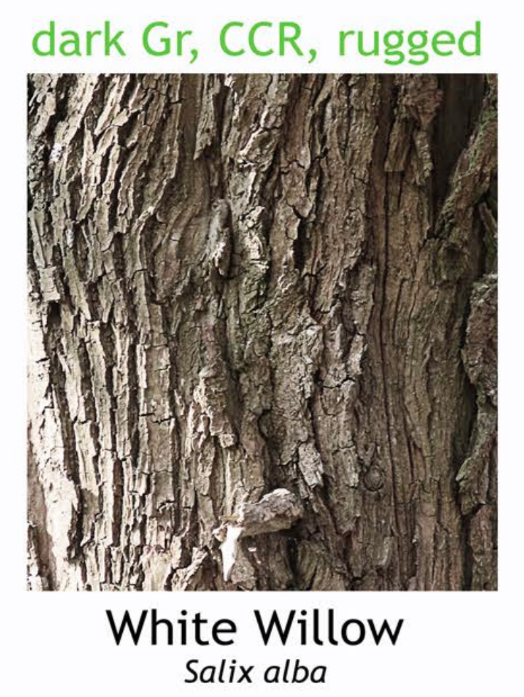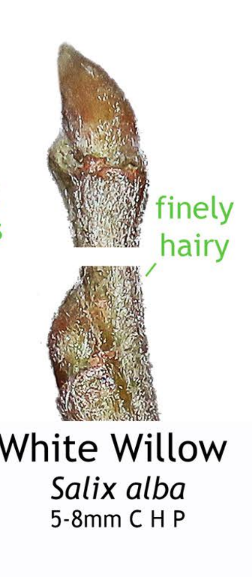A native deciduous tree species in Ireland, commonly found in wetland habitats, along riverbanks, and in damp woodlands.
Recognising the White Willow Tree:
-
Leaves: The leaves of the White Willow tree are alternate, lanceolate to ovate in shape, and have serrated margins. They are light green in colour on the upper surface and have a whitish or silvery underside, particularly when young.
-
Bark: The bark of the White Willow tree is smooth and greyish-brown when young, becoming rougher and more fissured with age. It may develop a reddish or yellowish tinge on older branches and trunks.
-
Catkins: White Willow trees produce catkins in early spring before the leaves emerge. The catkins are cylindrical in shape and appear in clusters on separate male and female trees. Male catkins are longer and more slender, while female catkins are shorter and more compact.
-
Habitat: White Willow trees are commonly found in wetland habitats, including marshes, fens, bogs, and riparian zones. They are often associated with other wetland species and can tolerate waterlogged soils and periodic flooding.
-
Shape: White Willow trees have a shrubby or small tree-like growth habit, with multiple stems arising from the base. They can grow to heights of 10-25 meters, depending on environmental conditions and growing conditions.



5 Interesting Facts about the White Willow Tree:
-
Historical Significance: White Willow trees have been valued for centuries for their medicinal properties. The bark of the tree contains salicin, a compound similar to aspirin, which has been used for pain relief and reducing fever since ancient times.
-
Fast Growth: White Willow trees are fast-growing species, capable of reaching maturity within a relatively short period. Their rapid growth rate makes them valuable for habitat restoration projects, erosion control efforts, and timber production.
-
Hybridisation: White Willow trees have the ability to hybridizs with other willow species, resulting in a diverse array of hybrids with varying characteristics. This hybridisation contributes to the genetic diversity of willow populations and may result in new combinations of traits suited to specific environmental conditions.
-
Wildlife Habitat: White Willow trees provide valuable habitat and food for a variety of wildlife species. The catkins are an important early food source for pollinators such as bees and butterflies, while the foliage provides shelter and nesting sites for birds and small mammals.
-
Cultural Significance: White Willow trees have cultural and symbolic significance in Celtic and other European traditions. They have been associated with protection, divination, and fertility and have been planted near homes, wells, and sacred sites for their perceived magical properties.
Uses of the White Willow Tree:
-
Medicinal Uses: White Willow trees have been traditionally used for medicinal purposes, particularly for pain relief and reducing fever. The bark contains salicin, which is converted to salicylic acid in the body and has anti-inflammatory and analgesic properties. It has been used to make traditional remedies such as willow bark tea.
-
Erosion Control: White Willow trees help stabilise soil and prevent erosion in wetland habitats, riverbanks, and riparian zones. Their extensive root systems help bind soil particles together and reduce the impact of water flow, making them valuable for erosion control and habitat restoration.
-
Timber Production: White Willow trees are sometimes harvested for timber production. The wood is lightweight, soft, and easily worked, making it suitable for a variety of uses, including furniture making, basket weaving, and pulp production.
Contribution to Biodiversity:
-
Habitat Provider: White Willow trees contribute to biodiversity by providing habitat and food for a wide range of wildlife species in wetland habitats, riparian zones, and woodland ecosystems. Their catkins are an important early food source for pollinators, while their foliage provides shelter and nesting sites for birds and small mammals.
-
Erosion Control: White Willow trees help stabilise soil and prevent erosion in wetland habitats and riparian zones. Their extensive root systems help bind soil particles together and reduce the impact of water flow, contributing to the health and stability of riverbanks and riparian ecosystems.
-
Water Quality Improvement: White Willow trees play a role in improving water quality in wetland habitats by filtering pollutants, reducing sedimentation, and absorbing excess nutrients from runoff. Their presence helps maintain the ecological integrity of wetland ecosystems and supports diverse populations of aquatic and terrestrial species.
In summary, the White Willow tree is recognisable by its light green leaves with whitish or silvery undersides, smooth greyish-brown bark, cylindrical catkins, and shrubby growth habit. It holds cultural significance, provides valuable resources for wildlife, and contributes to biodiversity and ecosystem health in Ireland's wetland habitats, riparian zones, and woodland ecosystems. Additionally, it serves as a medicinal plant, erosion control measure, and timber resource, supporting diverse populations of wildlife and enhancing ecosystem resilience in natural landscapes.
Images taken from the beautiful posters created by Phil Barnett and you can download these and/or purchase other great designs from his online shop.
